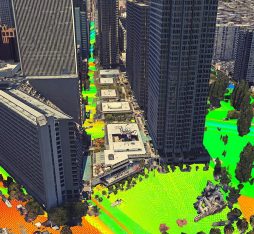• For some sectors, now is the time to act. Orange Quantum Defender provides institutions and companies with a set of solutions to ensure business continuity, even in the quantum computing era.
• Some components in this tool—such as quantum key distribution—leverage quantum properties. Others—such as post-quantum cryptology (PQC)—do not. Using algorithms based on more complex mathematical problems than current encryption processes, these can defeat a quantum computer.
Applying the laws of quantum physics to the computing field opens the door to unprecedented technological transformation, bringing opportunities… but also threats. The “second quantum revolution”, which involves leveraging the phenomena of superposition and entanglement, suggests the potential for an innovative breakthrough in the form of a quantum computer with unprecedented computing power.
Race against the clock: Pre-empting quantum decryption
This prospect calls into question the effectiveness of encryption, one of the foundations of economic and social trustworthiness in the digital age. , the mathematical algorithms on which today’s most prevalent public key encryption systems are based, could be easily and quickly overcome by a fairly sophisticated (“relevant”) quantum computer. “The potential of such a system, powerful and stable enough to launch quantum attacks, raises major security issues that are already palpable”, says Benjamin Vigouroux, VP, Digital Infrastructure at Orange Business. “Encrypted data is already being collected with malicious intent, with a view to decrypting it once sufficiently powerful quantum computers become available. These are “harvest now, decrypt later” attacks. This strategy threatens all sensitive data with a long lifespan, even if it seems safe today.”
The cryptography industry is preparing for this development. “Some institutions—particularly in the public, defence, healthcare and banking sectors—are preparing for this now by gradually moving towards post-quantum ( ) technologies and processes”. In the United States, the National Institute of Standards and Technology (NIST) is recommending that government agencies switch to quantum-resistant computer systems by 2035. This institute has begun to standardise and publish post-quantum encryption algorithms for protecting information shared over public networks and for digital signatures used for identity authentication.
Quantum Defender: Post-quantum cybersecurity from Orange
The Orange Group is responding to the challenge with the help of its research teams as well as the network and cybersecurity expertise in Orange Business and Orange Cyberdefense. Its new Quantum Defender offering positions the company as a facilitator in the transition to post-quantum technology.
It primarily assists organisations in: identifying systems that use vulnerable cryptography; classifying data according to its sensitivity and lifespan; prioritising migration; and subsequently integrating new secure solutions.
The value proposition goes beyond support and advice. “The offering includes a Quantum Safe as-a-Service component, to help with the software aspect of the transition and aimed at ensuring simplified, on-demand access to the appropriate Quantum Safe solutions. A third layer is linked to networks and systems supporting critical communications, requiring end-to-end quantum security.” This last point is about doubling the level of protection by combining much more robust cryptography solutions (PQC) and quantum key distribution technologies (QKD), in order to protect the most critical communications.
Defensive tools in this new paradigm: PQC and QKD
Post-quantum cryptography ( ) aims to counter attacks from quantum computers capable of executing Shor’s algorithm, which can solve the mathematical problems on which current encryption methods are based, in a matter of minutes. PQC is based on the application of new and much more complex mathematical equations, such as Euclidean networks, as opposed to current asymmetric algorithms (RSA and ECC). Many security agencies recommend that administrations and companies transition to PQC as soon as possible because it can be deployed in existing security architectures, providing an effective response to harvest now, decrypt later attacks.
Quantum key distribution ( ), otherwise known as quantum cryptography, is an alternative and complementary approach to PQC. It involves using the laws of quantum physics to securely exchange random encryption keys via optical networks (photons). QKD aims to ensure the confidentiality and integrity of the communications with which the keys are associated. Hackers trying to intercept a transmission would disrupt the photon entanglement, making the eavesdropper immediately detectable, and the secret key would be destroyed and subsequently renewed as a result. Orange researchers have been working on this topic since 2017 (ParisRegionQCI project).
A quantum-safe network in Île-de-France
These technologies are at the heart of the “Ring” announced by Orange at VivaTech, an infrastructure made quantum-safe thanks to PQC/QKD-compatible equipment supplied by Toshiba Europe. An integral part of Quantum Defender, this Ring deployed in Greater Paris allows administrations and businesses to protect their critical communications from current and future attacks. Quantum Defender is, in its entirety, a major innovation, calibrated to meet the challenges of quantum-safe transformation in all its dimensions (cultural, organisational, technical etc.). Defences against quantum computing threats are underway.
RSA (Rivest-Shamir-Adleman) and ECC (Elliptic Curve Cryptography) are among the most widely used public-key cryptographic algorithms and are based on mathematical problems. RSA, the older of the two, is supported across many platforms such as web browsers and email, while ECC is used for more recent system types such as mobile or IoT devices.
Refers to cryptographic methods or algorithms that can resist quantum computer attacks.
Post-quantum cryptography is a branch of cryptography that aims to develop algorithms and protocols capable of withstanding the computing power of quantum computers.
Quantum key distribution. A cryptographic protocol based on the properties of quantum physics. Allows two communicating users to generate a random secret key intended to protect a message, and to detect a possible interception by a third party seeking to access it.
 Benjamin Vigouroux
Benjamin Vigouroux











